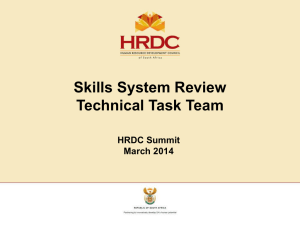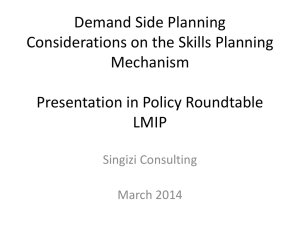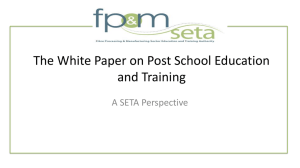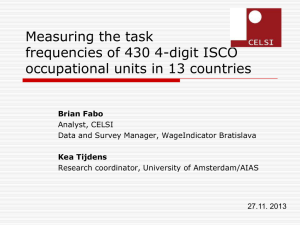Skills Planning for SIPs: Methodology used & reflections on possible
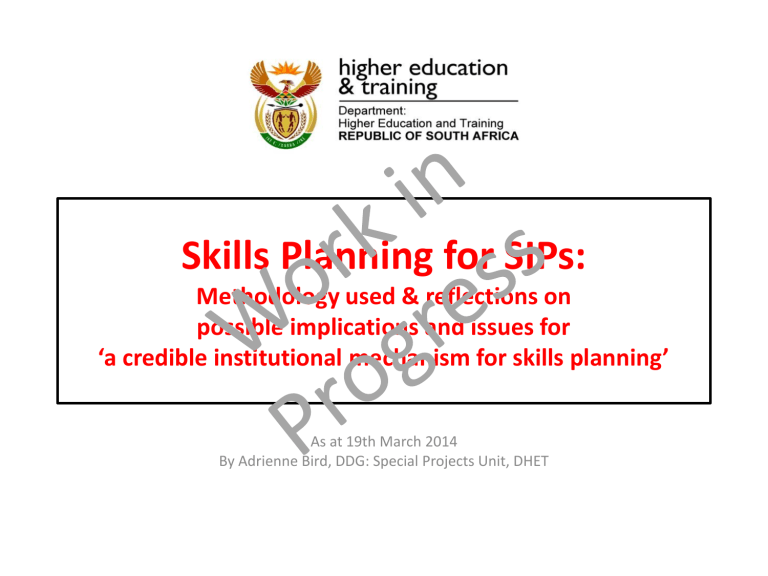
Skills Planning for SIPs:
Methodology used & reflections on possible implications and issues for
‘a credible institutional mechanism for skills planning’
As at 19th March 2014
By Adrienne Bird, DDG: Special Projects Unit, DHET
Introduction
This is as much about ‘our future’ as about ‘yours’.
SIPs planning to become part of
‘mechanism’
The document therefore has two purposes:
to describe the methodology being used by the
SIPs team
Delivery pressure
building model as we go
Lessons and convergence to reflect on the possible implications of the methodology being used for the
‘credible mechanism’
The PICC is impatient of delays – wants numbers
SUMMARY OF METHODOLOGY
Occupations required
Occupations in demand
Inform DHET institutions
Occupational Teams
Engagement with SETAs
Engagement with
Engagement with Institutions
Reporting
M&E & Reports
Occupations required
• All PICC projects have been grouped under a list of sectors and subsectors
• A typical size project has been selected for each sub-sector
• A skills prototype has been developed for each typical project
Occupations in demand
• Prototypes have been used to estimate the skills required for all real projects
• Technical experts have also been asked which positions are hard to fill
• List takes into account supply & nat. demand
• These estimations have been used to generate a 'occupations in demand' list
Critically scarce:
(50-100% scarcity)
SIPs Skills Plan:
Occupations in Demand
Surveyor 500
(incl land and eng. surveyors)
Materials Engineer 450
Grader Operator
Programme/ Project
Manager
Electronic Eng Technician
450
350
300
Gap 1 – broad estimates
Significantly scarce:
(20 – 50%)
Concreter
Bricklayer
Civil Engineer
Electrician
2500
1700
1400
1200
Electrical Engineer
Construction supervisor
1100
/clerk of works 1100
Electrical Engineering Technician
950
Millwright (incl. electromechanician) 600
Safety, Health, Environment and
Quality Practitioner 550
Boilermaker 500
Carpenter and Joiner
Mechanical Engineer
500
450
Ind. Machinery Mechanic 450
Construction Project
Manager / Site Manager 450
Plumber
Painter
400
400
Mech. Eng Technician 350
Draughtsperson 350
Excavator Operator
Environmental Eng
300
300
Chem Eng Technician 300
Pipe Fitter 300
Concrete Plant Worker 250
Earthmoving Plant
Operator 250
Plasterer
Welder
Quantity Surveyor
Rigger
250
220
200
200
Crane or Hoist Operator 200
0 – 20% scarcity not shown
6
Inform DHET institutions
• The 'scarce skills' list was given to DHET institutions for bottomup planning
• Institutions infuse into overall institutional priorities (e.g. SSPs for
SETAs, univ/college plan)
• Data collected from other data sources
Occupational Clusters Intermediate Bodies
Occupational Teams
Managers (primarily public sector)
Professionals & Associate
Professionals
Department of Public Service and
Administration
Council for the Built Environment
Service and Clerical Workers Services SETA
• Intermediate Bodies
Trades INDLELA, DHET
(IBs) set up to establish Transport/Construction SETAs
Occupational Teams Elementary and non-trade Construction Industry Development
(OTs) production workers Board
• DHET prepares standard reporting template
• Theory convener
• Training
Centre convener
Theory Practical
• OTs generate reports which include problem analysis & proposed solutions
• Workplace convener
Structure d workplace learning
Final assessm ent
• Assessor
Example
Mechanical Engineer Occupational Team and
Network
Occupational Team
University
University of Technology
Professional Body
Work Placed Training
SharePoint and Reporting per Occupation
Reports
Consolidated
Occupation
Information
Occupations required over time per location
SharePoint
Occupational Teams
Example of OT Report
From Entry to Expertise – learning pathway
Land Surveyors
OFO Occupation Theory Workplace Building capacity
216502 Land surveyors
Land and engineering surveyors are in short supply, but to increase the numbers more equipment and the development of more academics is essential.
MSc Scholarship for
10 @ R 100 000 per post grad p.a.
PhD Scholarship for 5
@ R 150 000 per post grad p.a.
R180 000 per candidate over 3 years. A total of 40 new candidates to be taken on annually
Increase enrolment, in all degrees through marketing: R
100 000 p.a.
Postgraduate research project support for UCT: R 250 000 p.a
Post graduate research project grant for 15 @ R 50 000
Equipment required for increased enrolment
UCT - R 2 755 000
UKZN - R 1 182 136
CHIETAs Commitments to SIP Scarce Skills – Feb 2014
Theory (Post-graduate /
OFO Occupation
No.
Bursaries)
Engagement with SETAs cost
Total
Workplace
No.
Unit Cost Total
• DHET engages one-onone with SETAs asking them to respond to OT reports;
212908
(Employed)
3 R 10,500
R 906,000 20
R 14,000
R 660,000
14 R 142,000 R 592,000 10 R 288,000 R 360,000
•
Programme and
SETAs interrogate
Professionals and associate
10 R 30,000 R 300,000 10 R 30,000 R 300,000 report in the light of their SSPs and make
R
12,421,900
796
R
28,813,000 commitments
214501
Chemical engineering (WIL)
149 R 294,200 R 5,198,200 153
R
2,074,800
R 5,619,600
•
Chemical
SETAs locate workplace learning sites thru’ grant incentives to
R 7,000
R 5,198,200 153
R 77,000
R
2,074,800
R 5,619,600
Other
(see definition above)
R 0
Key
R 0
Engage with institutions
• DHET engages one-onone with institutions
(or groups of institutions) asking them to respond to OT reports
• Institutions interrogate report in the light of their plans & make commitments integrated into enrolment, PQM and earmarked funding plans
Minister signs off Final plan
Linked to funding allocation
Institutional plan
OT plan
Key issue: Planning cycles
Centres of specialisation
(Differentiation - occupations
Reports and M&E
• Reports prepared 'up' to PICC and 'down' to institutions
• Monitoring and evaluation of commitments built into mainline reporting system back into DHET
INNOVATION ‘New Skills for New Jobs’ with EU
NB. Role of ESSA
Reflections
Central language:
‘Occupation’
Enables planning to migrate from ‘single employer’ needs to skill sets which will give learner maximum labour market mobility
Address debates:
Occupations and tasks
Occupations and sectors
Occupations and discipline knowledge
Occupational Teams – interface between demand and supply, built on
Advisory Committees of UOTs/Technikons, extend model to other clusters.
Note: Networks with ‘theme 4’ intermediate agencies.
Pathways (NCAP) is another way to map OFO to CESM. NLRD has data.
DANGER: If occupations are used exclusively, there is the danger that they become ‘islands’ and that progression is undermined. This danger could be managed by introducing the notion of the National Occupational
Pathway Framework (NOPF) structures where the experts that interface with the sectoral specialists are responsible for pathways of occupations and not ‘islands’.
O*NET
http://www.onetonline.org
• We are eager to tangibly demonstrate the benefits of detailed occupational information and to explore the ways it might inform human-resource development in South Africa.
• As a way to kick-start our involvement and to give you an occupation-centric resource to point to, I am contemplating asking
Alex to develop profiles of the occupations on South Africa’s critical skills list based on information in the O*NET database. We could combine these occupational profiles with existing research in our field on how best to train and develop the various knowledge, skills, and abilities that O*NET identifies as critical to these scarce occupations. All of this could be packaged into a report and presentation that we could deliver to DHET and/or the Human
Science Research Council.
Prof. Lori Foster Thompson <lfthompson.mail@gmail.com>
Reflections
Could ‘prototype’ model be used in other non-SIP contexts e.g. predictable service delivery contexts (government departments & entities own skill needs?) [Could be regularly reviewed]
If yes, this would be useful, inter alia, for workplace learning planning in public spaces.
Best results gained when prototype builders have specialist knowledge or at least some relevant technical expertise. This has implications for capacity of proposed Unit. (NOPF??)
Use standard tools e.g. ‘toolkit’ will make consolidation of data much easier. Will need standard ‘languages’ e.g. sector definitions

